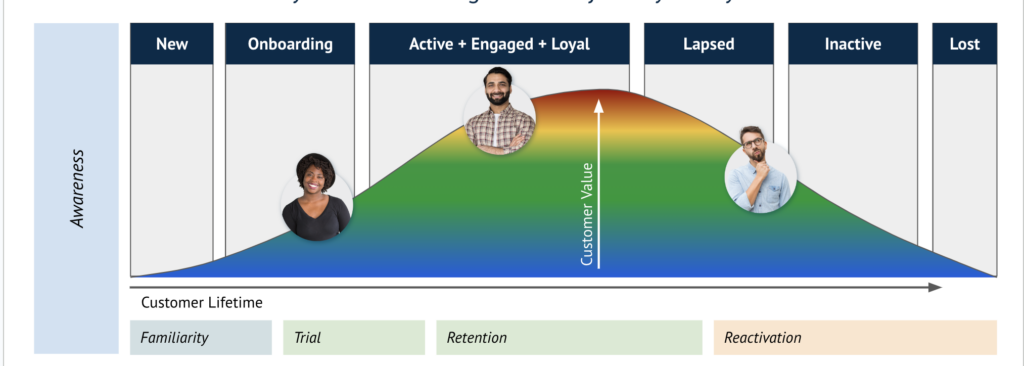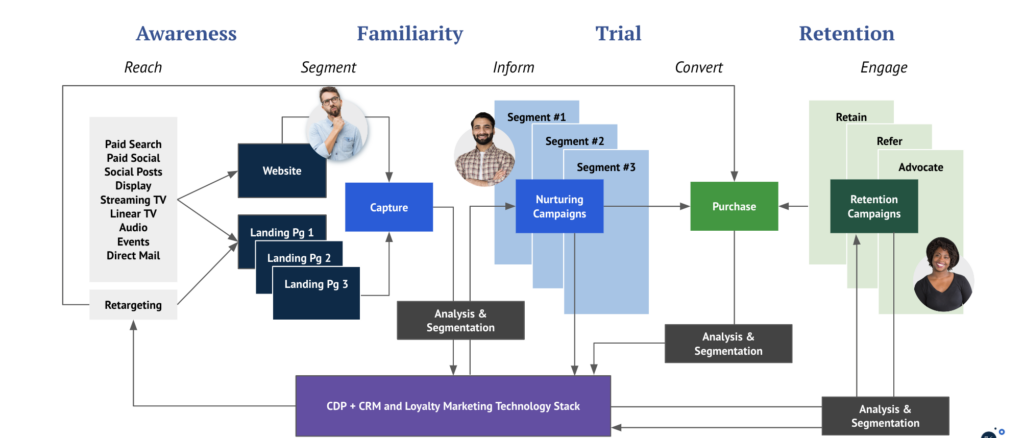By Juliana Spadaro, Response Labs
In the ever-evolving landscape of digital marketing, understanding and optimizing the customer journey is paramount for success. As a leading digital Customer Relationship Management (CRM) and loyalty marketing agency, we recognize the significance of customer journey mapping in creating personalized and seamless experiences. In this blog, we’ll explore the strategies and best practices that can elevate your customer journey mapping game and drive lasting customer satisfaction and loyalty.
Understanding Customer Journey Mapping
Customer journey mapping is the process of visualizing and understanding the entire lifecycle of a customer’s interactions with a brand. Its primary purpose is to gain insights into customer experiences, pain points, and preferences, enabling businesses to tailor their strategies and enhance customer satisfaction.
All customer journeys have core aspects in common, which we outline below as critical phases. However, every business, brand, and customer is different. The language you use to describe these phases might (and should!) vary to meet your needs. And of course, we recommend making sure all of these phases are as data-informed as possible so you can clearly define phases like loyalty (i.e. is it hitting three transactions, hitting one per month, or something else?)
Key Stages in Customer Journeys
- Awareness: The customer becomes aware of the brand.
- Consideration: The customer evaluates the brand and its offerings.
- Decision: The customer makes a purchase or engages in a transaction.
- Post-Decision: The customer experiences the product or service and seeks support if necessary.
- Loyalty: Building a long-term relationship with the customer to encourage repeat business.

Three Strategies for Effective Customer Journey Mapping
1) Data-Driven Insights
Leverage data from your CRM to gain insights into customer behaviors and interactions.
The data should clearly inform what your customer journey looks like. For example, many of our clients in the dining space recognize that “true” loyalty isn’t achieved with just one transaction or order. We work with clients to analyze customer behavior to identify the “tipping point” across recency, frequency, and monetary amount of each transaction that is associated with a brand’s most loyal guests. A fast-casual brand, for example, might need to achieve three transactions in 90 days to have the strongest chance of retaining a customer. That data point directly informs the design of the customer journey.
Analyze other touchpoints across your omnichannel experience.
Identify and analyze the various touchpoints where customers interact with your brand, including social media, website, emails, and customer service. Keep in mind that all of these touchpoints are critical junctures where you could make or break your customer’s overall experience. This is also a great exercise for ensuring that your brand content is aligned across all your channels and creates a cohesive experience for your customers.
2) Customer Personas
Develop detailed customer personas based on demographic data, behavior patterns, and preferences.
This helps in crafting personalized experiences for different groups of customers. Remember: customer personas aren’t the same thing as customer segments done via data-driven processes like RFM segmentation. Customer personas can (and should) be data-driven, but they serve as the more qualitative answer to quantitative-focused segmentation strategies.
Engage in an empathy mapping exercise to better understand your personas.
Put yourself in the customer’s shoes by empathizing with their needs, goals, and emotions at each stage of the journey. This fosters a deeper understanding of their perspective and helps you identify strengths or gaps in the existing customer experience flow you’ve created.
3) Omnichannel Integration
Ensure a consistent and seamless experience across all channels, whether it’s online, offline, mobile, or in-store.
Marketers can harness the comprehensive data stored in CRMs to gain valuable insights into customer interactions, behaviors, and preferences across various touchpoints. By integrating CRM with CDP, a unified customer profile is created, consolidating data from disparate channels into a centralized hub. This harmonious integration allows marketers to craft cohesive and personalized campaigns that resonate with individual customer journeys. With the ability to track and analyze customer interactions in real-time, marketers can deploy targeted and contextually relevant messaging across channels, ensuring a consistent and compelling brand experience.

Best Practices for Customer Journey Mapping
Continuous Iteration
The customer journey is dynamic. Regularly update and refine your maps based on changing customer behavior, market trends, and feedback. A key way to inform and adjust your strategies is by conducting regular A/B testing of critical communications at key points in your customer journey map.
And when you iterate, bring everyone to the table. Involve teams from various departments such as marketing, sales, and customer support to gather diverse perspectives and insights.
Real-Time Adaptation
Implement AI-driven tools and automation to analyze real-time data and adapt your strategies accordingly. These days, almost every CRM and CDP has built-in AI features that can optimize and enhance your customer journeys. For example, Salesforce Einstein is an AI-powered feature within the Salesforce CRM platform. It utilizes machine learning algorithms to analyze data, predict outcomes, and provide actionable insights. By leveraging machine learning, HubSpot AI helps identify patterns, predict future customer actions, and recommends personalized content, thereby contributing to effective customer journey mapping within the platform.
What This Means For You
Customer journey mapping is not just a tool; it’s an art that requires a blend of data analytics, empathy, and continuous adaptation. For this reason, it is something our team spends a lot of time thinking about and working on with our clients.
As a digital CRM and loyalty marketing agency, we understand the nuances of creating exceptional customer experiences. By implementing the strategies and best practices outlined above, you can chart a course toward customer-centricity, fostering lasting relationships and brand loyalty in the digital age. Remember, the journey is ongoing, and the key to success lies in the ability to evolve with your customers.
Response Labs is a Capitol Communicator sponsor.